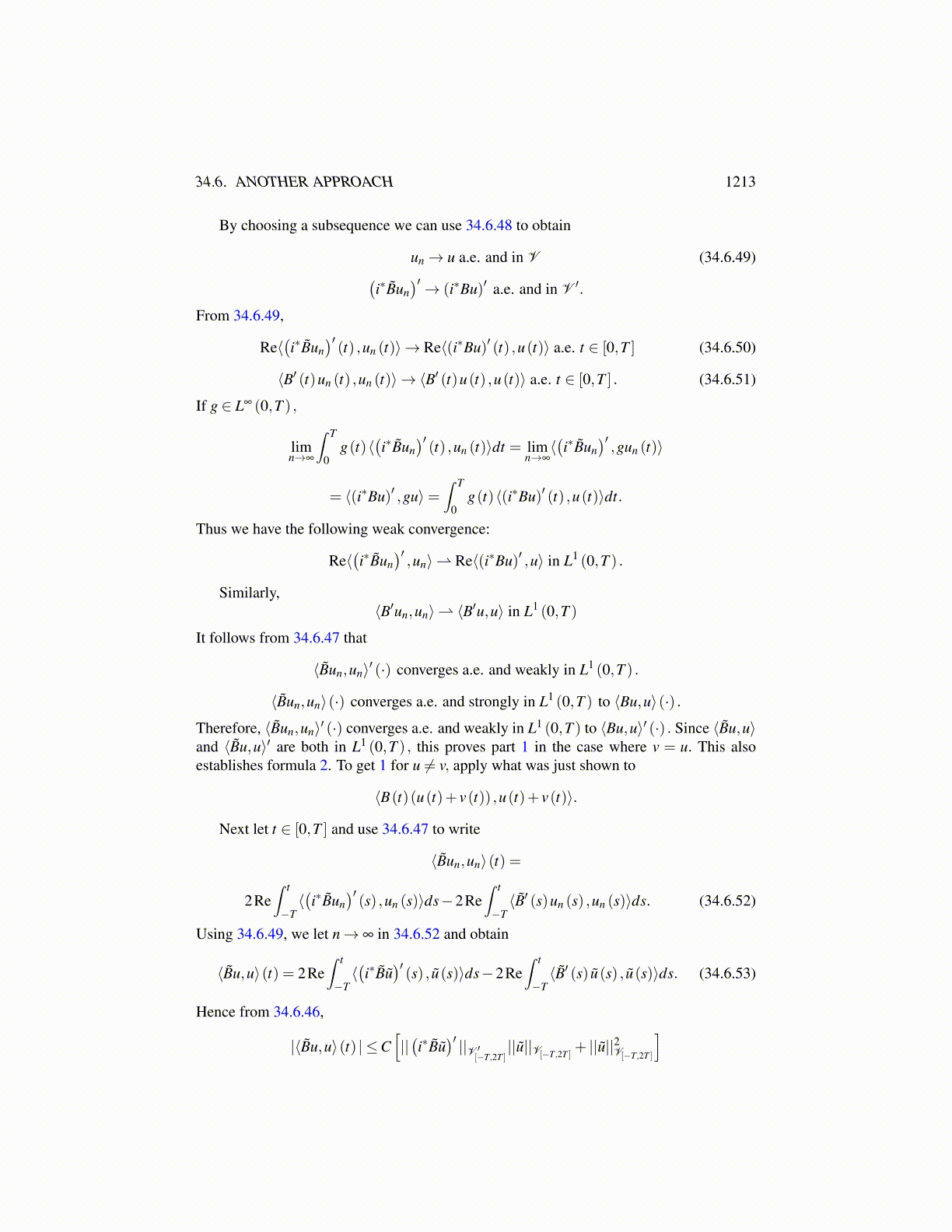
34.6. ANOTHER APPROACH 1213
By choosing a subsequence we can use 34.6.48 to obtain
un→ u a.e. and in V (34.6.49)(i∗B̃un
)′→ (i∗Bu)′ a.e. and in V ′.
From 34.6.49,
Re⟨(i∗B̃un
)′(t) ,un (t)⟩ → Re⟨(i∗Bu)′ (t) ,u(t)⟩ a.e. t ∈ [0,T ] (34.6.50)
⟨B′ (t)un (t) ,un (t)⟩ → ⟨B′ (t)u(t) ,u(t)⟩ a.e. t ∈ [0,T ] . (34.6.51)
If g ∈ L∞ (0,T ) ,
limn→∞
∫ T
0g(t)⟨
(i∗B̃un
)′(t) ,un (t)⟩dt = lim
n→∞⟨(i∗B̃un
)′,gun (t)⟩
= ⟨(i∗Bu)′ ,gu⟩=∫ T
0g(t)⟨(i∗Bu)′ (t) ,u(t)⟩dt.
Thus we have the following weak convergence:
Re⟨(i∗B̃un
)′,un⟩⇀ Re⟨(i∗Bu)′ ,u⟩ in L1 (0,T ) .
Similarly,⟨B′un,un⟩⇀ ⟨B′u,u⟩ in L1 (0,T )
It follows from 34.6.47 that
⟨B̃un,un⟩′ (·) converges a.e. and weakly in L1 (0,T ) .
⟨B̃un,un⟩(·) converges a.e. and strongly in L1 (0,T ) to ⟨Bu,u⟩(·) .
Therefore, ⟨B̃un,un⟩′ (·) converges a.e. and weakly in L1 (0,T ) to ⟨Bu,u⟩′ (·) . Since ⟨B̃u,u⟩and ⟨B̃u,u⟩′ are both in L1 (0,T ) , this proves part 1 in the case where v = u. This alsoestablishes formula 2. To get 1 for u ̸= v, apply what was just shown to
⟨B(t)(u(t)+ v(t)) ,u(t)+ v(t)⟩.
Next let t ∈ [0,T ] and use 34.6.47 to write
⟨B̃un,un⟩(t) =
2Re∫ t
−T⟨(i∗B̃un
)′(s) ,un (s)⟩ds−2Re
∫ t
−T⟨B̃′ (s)un (s) ,un (s)⟩ds. (34.6.52)
Using 34.6.49, we let n→ ∞ in 34.6.52 and obtain
⟨B̃u,u⟩(t) = 2Re∫ t
−T⟨(i∗B̃ũ
)′(s) , ũ(s)⟩ds−2Re
∫ t
−T⟨B̃′ (s) ũ(s) , ũ(s)⟩ds. (34.6.53)
Hence from 34.6.46,
|⟨B̃u,u⟩(t) | ≤C[||(i∗B̃ũ
)′ ||V ′[−T,2T ]
||ũ||V[−T,2T ]+ ||ũ||2V[−T,2T ]
]